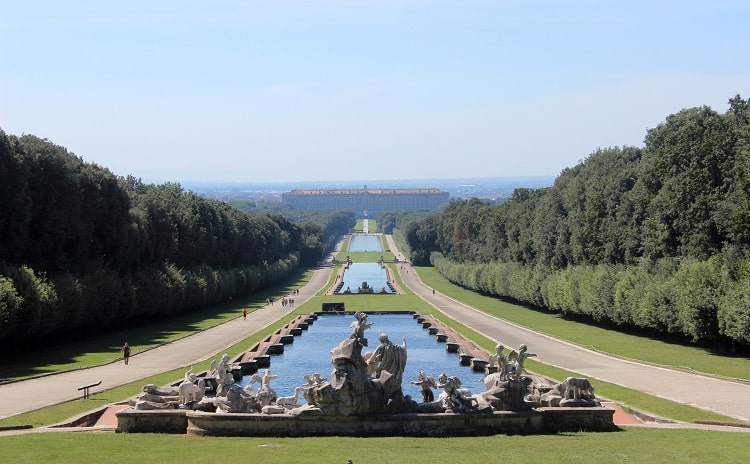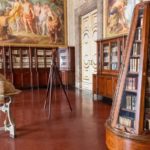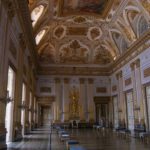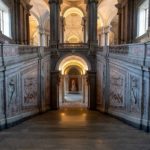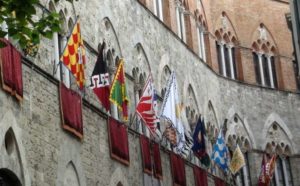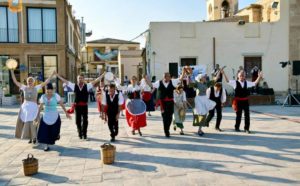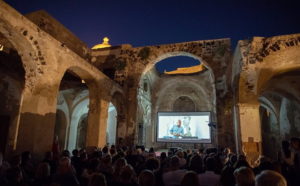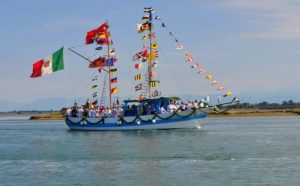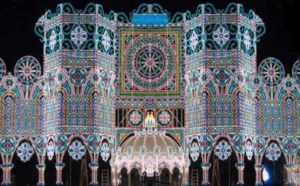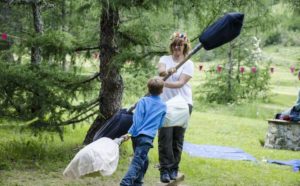The Royal Palace of Caserta is the royal residence built by the King Charles VII of Naples with the intention of making it a more beautiful and more sumptuous palace than Versailles. Projected in 1750, the works to built it began in 1752. The palace , which also houses an important library and a historical archive, is surrounded by a large park.
THE PALACE
The rectangular plan of the Palace overlooks four large internal courtyards and covers an area of approximately 47,000 square meters for 5 floors in height. With 1,000,000 cubic meters, it is the largest palace in the world by volume.
In the Palace there are 1,200 rooms facing outwards with 1,742 windows. The Grand Staircase of Honour connects the lower vestibule to the upper one, from where visitors enter the Royal Apartments.
The Royal Apartments
On the first floor of the Palace there are the Royal Apartments: that of the Queen in the North-West wing, while those of the King and the Crown Prince were in the South wing.
Today the Museum of the Royal Apartments that visitoris can see is only the area along the southern facade, and the tour is divided into an eighteenth-century apartment and a nineteenth-century apartment.

The Royal Nativity Scene
The tradition of the Nativity Scene was inaugurated by Charles VII of Naples and then taken up by his successors, in particular Francis I, a true lover of crib figures. The historical archive of the palace reveals that every Christmas the creation of the Nativity Scene involved not only artists and artisans but also the princesses and court ladies who dedicated themselves to the creation of the characters’ clothes.
The base is a cork structure called “the Block” and is over 40 square meters wide. On this, 1,200 figures are positioned, the most important ones made all in terracotta, the others in tow with only the hands, head, and feet in terracotta. The Nativity Scene that visitors can see today is a reconstruction because the original commissioned in 1844 by Ferdinand II, has been stolen in 1985. In the crib the traditional scenes of the Birth of Jesus and the Adoration of the Magi are represented, but also scenes inspired by Neapolitan traditions: the Pasture of the buffaloes, the Stop at the fountain, the Market and the Neapolitan Taverna with musicians and patrons, telling the daily life of that time.
The collections
Terrae Motus is the contemporary art collection housed in the Royal Palace since 1994. The creation of this collection is due to the Neapolitan gallery owner Lucio Amelio who called international artists to do something for Naples after the earthquake of 23 November 1980 that devastated Campania and Basilicata. On display about seventy works by Italian and international artists including Robert Mapplethorpe, Robert Rauschenberg, Keith Haring, Anselm Kiefer, Andy Warhol, Michelangelo Pistoletto…
The Palatine Library is on the Eastern side of the Palace and consists of five rooms: two antechambers and three rooms containing over 14,000 volumes. In the three frescoed rooms, there are also two barometers, a brass telescope and a pair of globes. One of the most important volumes of the entire collection is about the project of the Palace that was to be built in the following years with all the drawings of it.
The Historical Archive of the Royal Palace of Caserta, first established by the will of Ferdinand IV, preserves a set of archival collections that include over 10,000 envelopes and volumes, with documents covering a period of time from the fifteenth century to the mid-1900s.
THE ROYAL PARK
The Royal Park is inspired by the gardens of the great European residences of that time but introduces elements of the great Italian tradition of the Renaissance garden. It develops for 3 km in length and covers an area of 120 hectares.
The Gardens are divided into two sections: an Italian garden consisting of large parterres with a central avenue leading to Margherita Fountain, with groves of holm oaks and hornbeams, symmetrically arranged to form a semicircular green “theatrical” scene.
The English garden, created by John Andrew Graefer and commissioned by Queen Maria Carolina of Habsburg-Lorraine, constitutes the second section. Rich in numerous native and exotic plants and characterized by an apparent disorder, the English garden alternates fountains, water basins, meadows and waterfalls. The fountains are fed by the Carolino Aqueduct, inaugurated in 1762. The Carolino aqueduct has been built in tunnels crossing 6 reliefs and 3 viaducts and it is still considered one of the most important works created by the Borbone family.
San Silvestro Royal Estate was part, together with the Royal Park and the English Garden, of the “Royal Delights” annexed to the Royal Palace of Caserta.
Today San Silvestro Estate is an Oasis belonging to WWF, which takes care of the plants and organizes all the visits inside it.
The visit also includes the Court Theater. It was not foreseen in the initial project of the building, and its construction began in 1756, three years after the start of the works for the Palace.
In 1997 the Royal Palace of Caserta was declared a UNESCO World Heritage Site.
USEFUL INFORMATION
See the website>>>
Tickets on the website>>>
See also the Facebook page of the Royal Palace of Caserta >>>
Photos from the official website and from Wikipedia Creative Commons Licence
Cover photo – Miguel Hermoso Cuesta – Opera propria, CC BY-SA 3.0,
Exterior of thepalace – Tango7174 – Opera propria, CC BY-SA 4.0,
Royal Palace inside – I, Japiot, CC BY 2.5,

